RUMEX
Rumex
L., Sp. Pl. 1: 333. 1753; Gen. Pl. ed. 5: 156. 1754; Boiss., Fl. Or. 4: 1003. 1879; Hook. f., Fl. Brit. India 5: 58. 1890; Tutin et al., Fl. Europ. 1: 82. 1964; Collett, Fl. Siml. ed. 2: 427. 1921 (Reprint 1980); Fl China @ eFloras.org 5: 333; Fl. North Amer. @ eFloras.org vol. 5; Fl. Pak. @ eFloras.org Pakistan V. 205.
Annual, biennial or perennial herbs, rarely shrubs, with long, stout tap roots, sometimes rhizomatous. Stem erect, rarely ascending or prostrate, grooved. Leaves cauline, basal in some species, alternate, simple; ochrea persistent or partially deciduous, membranous; petioles present on basal and proximal leaves, distal cauline leaves sessile; blades variable in shape, basal and proximal cauline leaves broadly ovate, almost orbiculate to linear, becoming smaller and narrower distally, margin entire or undulate. Flowers actinomorphic, bisexual, unisexual or polygamous, small, green, often turning red, in whorl-like distant clusters forming terminal or axillary racemes or branching into panicles. Pedicels articulate (the functional pedicel consists of true pedicel and below the joint, the narrowed united basal parts of outer tepals). Tepals 6, connate proximally, in 2 whorls of 3 each, dimorphic, the outer remaining small and thin, the inner becoming enlarged and often hardened in fruit termed “Valves”; valve margin entire, erose, denticulate or variously dentate, midvein often transformed into tubercles ( tuberculate callosities). Stamens 6, in 2 whorls of 3 each; anthers bithecous, basifixed; filaments free, glabrous. Carpels 3, syncarpous; ovary trigonous, unilocular with a solitary basal ovule; styles 3, free, spreading or reflexed; stigmas 3, fimbriate. Achenes ( nuts) brown, trigonous, enclosed in 3, enlarged and finely net-veined inner segments of perianth ( fruiting sepals or valves).
193 species
Rumex dentatus subsp. klotzschianus
Rumex dentatus
L. subsp. klotzschianus (Meisn.) Rech. f., Beih. Bot. Centralbl. 49(2): 19. 1932; Babu, Herb. Fl. Dehradun 446. 1977; Kaur & Sharma, Fl. Sirmaur 555. 2004; Singh & Sharma, Fl. Chamba Dist. 612. 2006; Fl. Pak. @ eFloras.org Pakistan V. 205; R. dentatus L., Mant. Pl. 2: 226. 1771; Hook. f., Fl. Brit. Ind. 5: 59. 1890; R. klotzschianus Meisn., Prodr. 14(1): 57. 1856.
Annual herb. Stem erect, 30-70(-100) cm tall, branched from base, grooved, fistular, glabrous, purple-tinged. Leaves alternate, simple; ochrea deciduous or partially persistent at maturity, membranous. Basal leaves: Petiole 3-8(-12) cm long; leaf blade oblong, ovate- oblong to narrowly elliptic, 6.5-12(-14.5) cm x 2-4(-5) cm, both surfaces glabrous, base truncate, rounded or subcordate, margin entire or slightly undulate, apex obtuse or acute; Cauline leaves: Normally few, morphology nearly similar to basal leaves, but becoming gradually smaller upwards with shorter petioles. Leaves in inflorescence with narrow, linear-lanceolate, lanceolate-elliptic leaf blade with acute apex and petiole ca. 1/2 or less the length of leaf blade. Inflorescence racemose, several racemes aggregated and panicle-like in upper half or more of plant. Flowers actinomorphic, bisexual, hypogynous, green, in mostly distant dense whorls, each whorl with up to 30 flowers associated with single leaf. Pedicels 2-5 mm long, articulated in proximal 1/3rd. Tepals 6, connate proximally, in 2 whorls of 3 each; outer tepals elliptic, ca. 2 mm long; inner tepals enlarged and hardened in fruits termed as “valves”. Stamens 6, in 2 whorls of 3 each; filaments short, ca. 0.25 mm long, glabrous; anthers ca. 1 mm long, bithecous, oblong, basifixed. Carpels 3, syncarpous; ovary trigonous, unilocular with solitary basal ovule; styles 3, free; stigmas fimbriate. Achenes (nuts) yellowish-brown, shiny, ovoid, 2-3 mm x 1.4-1.8 mm, apex acute, base narrow; fruiting perianth segments (valves) triangular-ovate, 4-5 mm long and 2.5-3 mm wide (without teeth), margin with 2-4 teeth on each side, teeth 1.5-2(-3) mm long, valves conspicuously net-veined, base round or truncate, apex acute to subacute; all 3 valves with oblong tubercles, ca. 2 mm long, sometimes only 1 or 2 valves have tubercles.
Common Names: Toothed Dock, Dentate Dock, Indian Dock; Jangli Palak (Hindi)
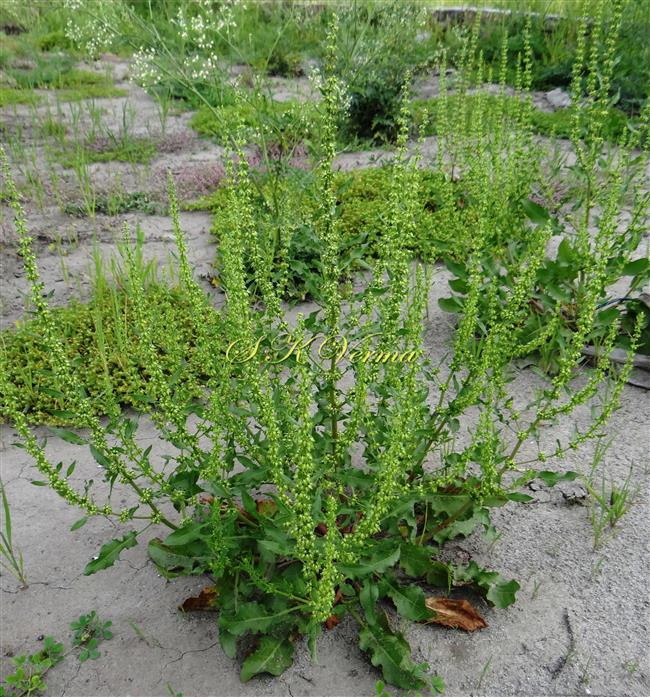
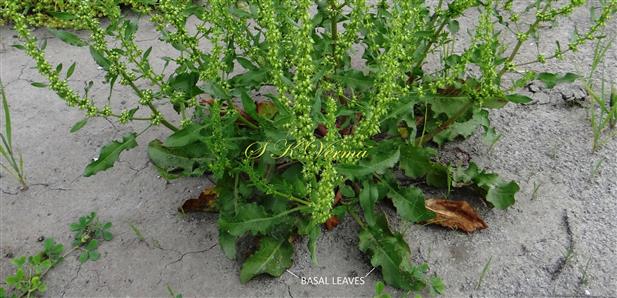
-3509.jpg)
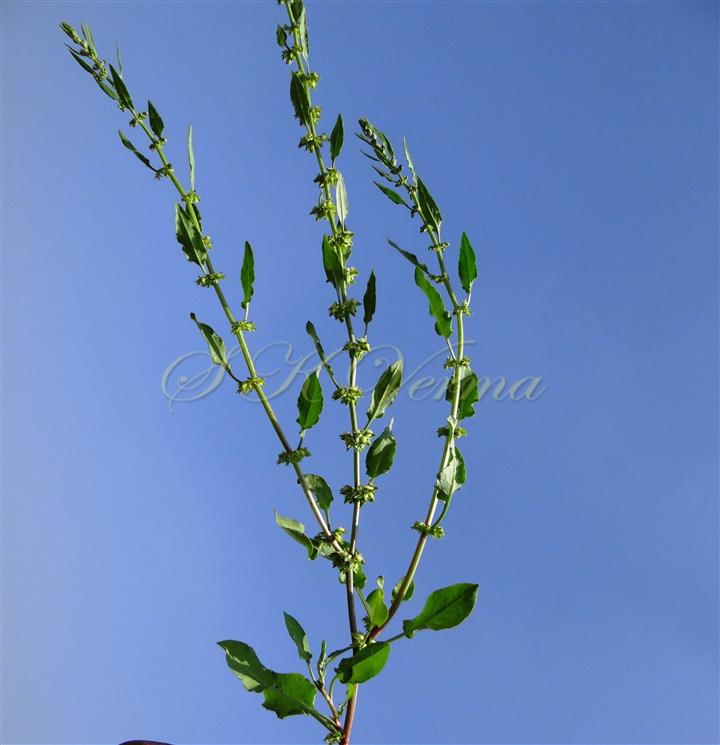
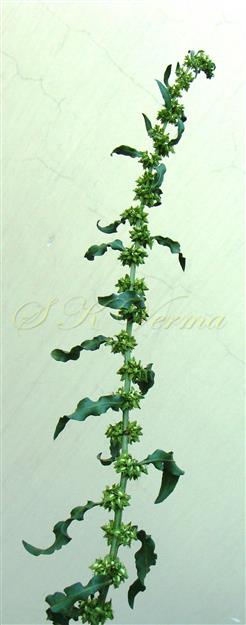


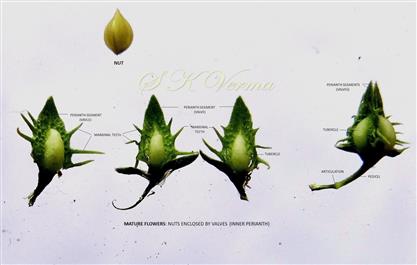
 -DSC04662.jpg)
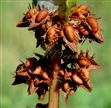



-3509.jpg)





 -DSC04662.jpg)
